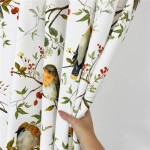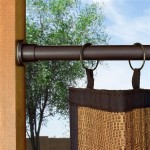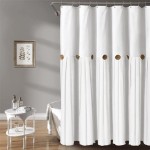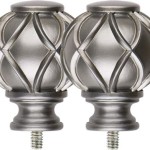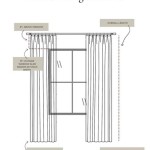Custom Curtain Rods For Bay Windows: A Comprehensive Guide
Bay windows, with their architectural charm and ability to flood a room with natural light, present unique challenges when it comes to window treatments. Standard curtain rods often fall short in accommodating the angles and curves inherent in a bay window configuration. This is where custom curtain rods emerge as a practical and aesthetically pleasing solution. Tailored to the precise dimensions and design of a specific bay window, these rods offer unparalleled flexibility and control over light, privacy, and the overall visual appeal of a space.
The selection of custom curtain rods for bay windows requires careful consideration of several factors, including the window's architecture, the desired aesthetic, the type of curtains to be hung, and the functional requirements of the room. Ignoring these aspects can lead to unsatisfactory results, both in terms of appearance and performance. This article will explore the key considerations and options available when choosing custom curtain rods for bay windows.
Accurately Measuring Bay Windows for Custom Rods
The foundation of a successful custom curtain rod installation lies in precise measurement. Bay windows are rarely perfectly symmetrical, and even slight inaccuracies in measurements can result in gaps, sagging, or an ill-fitting rod. A meticulous approach to measuring is paramount.
The process begins by identifying the exact points where the rods will be mounted. These points should ideally be directly above the window frame, offering maximum support and allowing the curtains to stack neatly when open. Once the mounting points are established, each section of the bay window needs to be measured individually. This includes the length of each straight section and the angle of each corner.
For the straight sections, measure the distance between the two mounting points along the plane of the wall. Repeat this process for each straight section of the bay window. It is crucial to use a high-quality measuring tape and ensure it is held taut and level. To account for any slight variations in wall depth or irregularities, it is advisable to take multiple measurements and use the largest measurement.
Determining the angle of each corner requires a protractor or a specialized angle-measuring tool. If an angle finder is unavailable, a simple workaround involves using two straight edges, such as rulers or pieces of cardboard. Place one straight edge along one side of the corner and the other straight edge along the other side. Then, measure the distance between the ends of the straight edges and use this measurement, along with the length of the straight edges, to calculate the angle using trigonometric functions. Alternatively, a template of the bay window angle can be created and sent to the rod manufacturer for accurate fabrication.
After obtaining all the necessary measurements, it is essential to create a detailed sketch or diagram of the bay window, clearly labeling each section with its corresponding measurements and angles. This diagram will serve as a blueprint for the custom rod manufacturer, ensuring that the final product accurately reflects the window's dimensions. Double-checking all measurements before submitting them is highly recommended to minimize the risk of errors.
Furthermore, consideration should be given to the projection of the rod from the wall. This measurement determines how far the curtains will hang from the window, influencing the amount of light blocked and the overall aesthetic. The projection should be sufficient to prevent the curtains from rubbing against the window frame or interfering with any window hardware, such as handles or cranks. It also impacts the stacking space for the curtains when they are open. Insufficient projection can lead to a cramped and awkward appearance, while excessive projection may detract from the window's architectural details.
Selecting the Right Material and Style for Bay Window Curtain Rods
The choice of material and style for custom curtain rods significantly impacts both the aesthetics and functionality of the window treatment. The material should be durable enough to support the weight of the chosen curtains and complement the room's overall design style. Style considerations include the rod's finish, diameter, and decorative elements, all of which contribute to its visual appeal.
Common materials used for custom curtain rods include metal, wood, and composite materials. Metal rods, typically made of steel, aluminum, or wrought iron, offer excellent strength and durability. They are well-suited for supporting heavy curtains and can be finished in a variety of colors and textures, ranging from sleek and modern to rustic and traditional. Steel rods are particularly robust and can withstand significant weight, making them ideal for large bay windows or curtains made of heavy fabrics. Aluminum rods are lighter than steel and resistant to corrosion, making them a good choice for damp environments, such as bathrooms or kitchens.
Wood rods provide a warm and natural aesthetic that complements traditional and transitional décor. They can be crafted from a variety of wood species, each with its unique grain pattern and color. Wood rods are typically less strong than metal rods and are better suited for lighter curtains. The finish options for wood rods are extensive, ranging from natural stains to painted colors, allowing for seamless integration with the room's existing color scheme.
Composite materials, such as resin or fiberglass, offer a combination of strength, durability, and affordability. They are often used to mimic the appearance of wood or metal and can be molded into intricate shapes and designs. Composite rods are resistant to moisture and warping, making them a practical choice for any room.
The style of the curtain rod should be congruent with the overall design of the room. For modern and minimalist spaces, sleek metal rods with simple finials are a popular choice. Traditional rooms may benefit from ornate wood rods with decorative finials or tiebacks. The diameter of the rod should also be proportionate to the size of the window and the weight of the curtains. A thicker rod is generally required for heavier curtains to prevent sagging and ensure smooth operation.
The finish of the curtain rod plays a crucial role in its visual appeal. Metal rods can be finished in a variety of colors, including brushed nickel, oil-rubbed bronze, and polished chrome. Wood rods can be stained or painted to match the room's trim or furniture. The finish should be durable and resistant to scratching and fading. Matte finishes tend to be more forgiving of imperfections, while glossy finishes can add a touch of glamour. Consider the existing hardware in the room, such as door handles and light fixtures, when selecting a finish to ensure a cohesive look.
In addition to the rod itself, the selection of finials, brackets, and rings or gliders is equally important. Finials are the decorative end pieces that adorn the rod, adding a touch of elegance and personality. Brackets provide support for the rod and should be chosen based on the weight of the curtains and the type of wall construction. Rings or gliders allow the curtains to move smoothly along the rod. The type of rings or gliders will depend on the type of curtain heading, such as grommets, pleats, or tabs. Silent gliders, which utilize a nylon or Teflon lining, are a popular choice for minimizing noise when opening and closing the curtains.
Addressing Functionality and Installation Considerations
Beyond aesthetics, the functionality of custom curtain rods for bay windows is paramount. The rods must be designed and installed to allow for smooth and effortless curtain movement, proper light control, and adequate privacy. The installation process should be carefully planned and executed to ensure the rods are securely mounted and aligned correctly.
The curvature of bay windows necessitates the use of specialized connectors or corner pieces that allow the rod to bend seamlessly around the angles. These connectors should be strong and durable, capable of supporting the weight of the curtains without sagging or breaking. The type of connector will depend on the angle of the bay window and the material of the rod. Flexible connectors, which can be adjusted to accommodate various angles, are a versatile option. Pre-bent corner pieces, which are custom-made to a specific angle, offer a more precise and seamless look.
The type of curtain heading should also be considered when selecting custom curtain rods. Grommet curtains, which have metal rings sewn into the top edge, require a rod with a slightly larger diameter to allow the grommets to slide freely. Pleated curtains, which have fabric folds sewn into the top edge, require hooks or pins that attach to rings or gliders. Tab-top curtains, which have fabric loops sewn along the top edge, require a rod with a smaller diameter to allow the tabs to slide easily. The choice of curtain heading will affect the appearance of the curtains and the ease of operation.
The installation of custom curtain rods for bay windows can be challenging, especially for inexperienced DIYers. It is often recommended to hire a professional installer to ensure the rods are properly mounted and aligned. The installer will have the necessary tools and expertise to handle any unforeseen challenges, such as uneven walls or hidden wiring. If attempting a DIY installation, careful planning and preparation are essential.
Before beginning the installation, gather all the necessary tools, including a drill, level, measuring tape, screwdriver, and stud finder. Locate the wall studs in the area where the brackets will be mounted. Mounting the brackets directly into the studs provides the strongest support for the rods. If studs are not available, use drywall anchors that are rated to support the weight of the curtains. Mark the location of the brackets on the wall, ensuring they are level and evenly spaced. Drill pilot holes for the screws and then attach the brackets to the wall using the appropriate fasteners.
Once the brackets are installed, slide the curtain rod through the rings or gliders and then place the rod onto the brackets. Secure the rod to the brackets using set screws or other fasteners. Ensure the rod is level and that the curtains move smoothly along the rod. If necessary, adjust the brackets or connectors to achieve optimal alignment and functionality.
Finally, consider the addition of accessories, such as tiebacks or holdbacks, to further enhance the functionality and aesthetics of the window treatment. Tiebacks are fabric or metal bands that hold the curtains open, allowing more light into the room. Holdbacks are decorative hooks or knobs that attach to the wall and serve the same purpose as tiebacks. The placement of tiebacks or holdbacks will depend on the style of curtains and the desired effect. They should be positioned at a height that allows the curtains to drape gracefully when open.

Custom Bay Window Rods

Bay Window Iron Curtain Rod Paso Robles Ironworks

Curved Drapery Poles Brimarbrimar

Graber Two Angle Custom Bay Window Traverse Rod Free Shipping

A Tale Of Bay Window Curtain Rod My Decorating Tips

Rod Desyne 1 In Pipe Bay Window Curtain Black

Twopages Jaylon Bay Window Curtain Rods Black

Custom Bay Window 1 Iron Curtain Rod In 4 Finishes Extra Long Available Capri

Bay Window Curtains Solutions Inspiration The Shade

Custom 1 5 Estate Bay Window Iron Curtain Rod In 4 Finishes Extra Long Available Grand Ball Bestwindowtreatments Com


